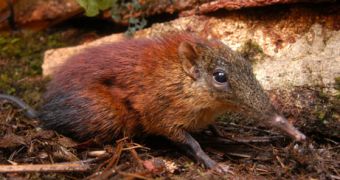This is the elephant of all shrews. Africans call them sengi, Europeans call them elephant shrews because they resemble giant shrews with long trunk-like flexible snouts. Surprisingly, they were right in a proportion of 50%: DNA has revealed that they are indeed related to elephants, and not to actual shrews, which are related to hedgehogs and moles. They are considered living fossils, restricted to Africa, that have remained unchanged for 35 million years.
And here comes the giant of the sengi, described in the "Journal of Zoology": the new squirrel-size species, the first sengi species to be discovered in over a century, is the largest species ever. The gray-faced sengi (Rhynchocyon udzungwensis) weighs 1.5 pounds (0.7 kg), 50% more than the next largest sengi, and was firstly detected in 2005 by motion-sensing cameras placed in the Udzungwa Mountains (south-central Tanzania).
"Photos showed a giant species that looked very different from known elephant shrews," said the species' discoverer, Francesco Rovero of the Trento Museum of Natural Sciences in Italy, who had been studying the forest fauna if Udzungwa for 6 years. A 2006 expedition confirmed the existence of the species. Traditional snares made of twine were used for capturing live specimens.
"We got four of them this way. The team also found a partially eaten specimen, the victim of a bird of prey," said Rovero. The gray-faced sengi has a specific gray face and black lower rump, being 8.3 inches (21 cm) longer (tail included) and 25 to 50% heavier than the next largest elephant shrew.
"The newfound species is the fourth member of the genus Rhynchocyon, a group known generally as giant elephant shrews because of their large sizes. They are confined to East Africa and are mainly forest dwellers," said Rovero about the insectivorous mammals.
The larger size of the new species could be an adaptation to its cooler habitat (larger animals retain the heat easier): the species inhabits damp mountain forests at over 3,280 ft (1,000 m), in only two places in the Udzungwa Mountains. "It is set to be listed as endangered by the World Conservation Union, though the animal's isolation gives it a favorable outcome," said Rovero.
"Giant elephant shrews are traditionally hunted by local tribes. They are big enough prey for eating. But the new species is not too close to people, because it's in a forest reserve," added Rovero.
"The mammal's range falls within the Udzungwa Mountains National Park and the newly announced Kilombero Nature Reserve. During the recent surveys we recorded few signs of disturbance, including hunting and tree-cutting, in the areas where the elephant shrew has been recorded," Nike Doggart of the Tanzania Forest Conservation Group, a nongovernmental organization based in Dar es Salaam, told National Geographic News.
"However, human populations are growing in adjacent areas. This may pose a threat in [the] future as demand for land and forest resources in the Udzungwas increases," added Doggart.
"The region harbors at least a hundred species of mammals, birds, amphibians, and other vertebrates found nowhere else. Given that the moist forests of the Eastern Arc only cover about 3,300 square kilometers [1,275 square miles], this represents one of the highest concentrations of endemic species in the world," she said.

 14 DAY TRIAL //
14 DAY TRIAL //